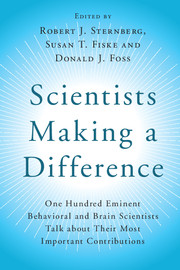 Scientists Making a Difference
Scientists Making a Difference Book contents
- Frontmatter
- Contents
- List of Contributors
- Foreword: Making a Creative Difference = Person × Environment
- Preface
- Part I Introduction
- Part II Biological Bases of Psychology: Genes, Brain, and Beyond
- Part III Cognition: Getting Information from the World and Dealing with It
- Part IV Development: How We Change Over Time
- Part V Motivation and Emotion: How We Feel and What We Do
- Part VI Social and Personality Processes: Who We Are and How We Interact
- Section A Social Cognition
- 74 Doing Good by Doing Good Research
- 75 The Incredible Little Shrinking Man in the Head
- 76 Ethnocentrism and the Optimal Distinctiveness Theory of Social Identity
- 77 Psychology of Gender: Nature and Nurture Working Together
- 78 How Warmth and Competence Inform Your Social Life
- 79 Two Routes to Persuasion
- Section B Personal Relationships
- Section C Group and Cultural Processes
- Part VII Clinical and Health Psychology: Making Lives Better
- Part VIII Conclusion
- Afterword: Doing Psychology 24×7 and Why It Matters
- Index
- References
77 - Psychology of Gender: Nature and Nurture Working Together
from Section A - Social Cognition
Published online by Cambridge University Press: 05 August 2016
- Frontmatter
- Contents
- List of Contributors
- Foreword: Making a Creative Difference = Person × Environment
- Preface
- Part I Introduction
- Part II Biological Bases of Psychology: Genes, Brain, and Beyond
- Part III Cognition: Getting Information from the World and Dealing with It
- Part IV Development: How We Change Over Time
- Part V Motivation and Emotion: How We Feel and What We Do
- Part VI Social and Personality Processes: Who We Are and How We Interact
- Section A Social Cognition
- 74 Doing Good by Doing Good Research
- 75 The Incredible Little Shrinking Man in the Head
- 76 Ethnocentrism and the Optimal Distinctiveness Theory of Social Identity
- 77 Psychology of Gender: Nature and Nurture Working Together
- 78 How Warmth and Competence Inform Your Social Life
- 79 Two Routes to Persuasion
- Section B Personal Relationships
- Section C Group and Cultural Processes
- Part VII Clinical and Health Psychology: Making Lives Better
- Part VIII Conclusion
- Afterword: Doing Psychology 24×7 and Why It Matters
- Index
- References
Summary
In the first half of my career I happily concentrated on the study of attitudes, a core area of social psychology. This work investigated how attitudes are structured in people's minds and how they influence all stages of their information processing, from exposure and perception to interpretation and memory. Although strong attitudes are often enduring, they can be changed by information and life experience. Attitude theory and research deal with the nuances of these processes.
As a culmination of my work on attitudes, I wrote a book, The Psychology of Attitudes, with Shelly Chaiken, that summarized everything that I knew about attitudes as of the early 1990s. Writing this book was an intellectual adventure, a high point in my work in psychology. I then carried my understanding of attitudes into work on other topics.
Even as I concentrated on the study of attitudes, I began to work on the psychology of gender, another area presenting fundamental questions about human psychology. My grounding in social psychology, especially in attitudinal processes, gave me intellectual capital that is critical to understanding how gender is created and played out in everyday behavior. Also useful was my educational background, which incorporated sociology and anthropology along with psychology.
I began my research on gender during the women's movement of the 1970s, when these questions took on special urgency. Many people were asking questions about gender that deserved answers based on scientific research. The overarching question was – and still is – the extent to which women and men are psychologically different, and, if they are different, why that is so. Are differences rooted in nature or nurture? Most psychologists, as well as most people who have taken a psychology course, would say that nature and nurture act together to produce some differences and many similarities in women and men. That view is scientifically valid as far as it goes, but of course it is the details that matter.
In studying a broad area such as gender, it is helpful to have a theoretical stance. I have done that with social role theory, which posits that sex differences and similarities arise primarily from the positioning of men and women in social roles within their society. In all known societies, social roles are to some degree segregated by sex.
- Type
- Chapter
- Information
- Scientists Making a DifferenceOne Hundred Eminent Behavioral and Brain Scientists Talk about Their Most Important Contributions, pp. 365 - 368Publisher: Cambridge University PressPrint publication year: 2016
